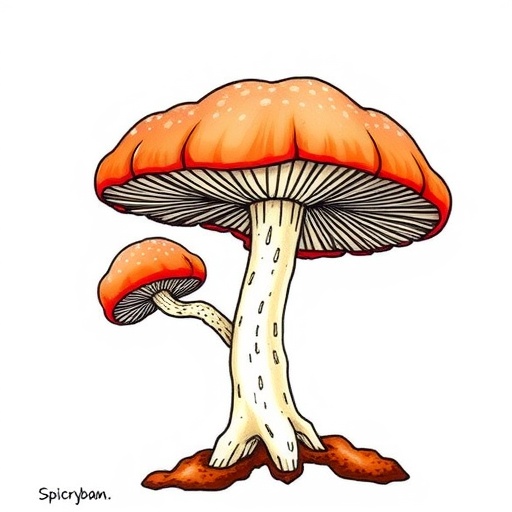In a groundbreaking synthesis that bridges clinical observations with rigorous animal modeling, researchers at the Florey Institute of Neuroscience and Mental Health have unveiled compelling evidence positioning psilocybin as a transformative agent against obsessive-compulsive behaviors. Published in the journal Psychedelics, this systematic review navigates the intricate terrain of compulsivity, integrating findings from 13 meticulously vetted studies, including human trials and preclinical experiments, to present a cohesive narrative on psilocybin’s therapeutic promise.
Obsessive-compulsive disorder (OCD) and related syndromes form a complex cluster of psychiatric conditions characterized by intrusive thoughts and repetitive ritualistic behaviors. Traditional treatments often fall short, especially in cases resistant to serotonin reuptake inhibitors. This review sharply focuses on psilocybin, the serotonergic psychedelic prodrug derived from Psilocybe mushrooms, spotlighting its potential beyond mood disorders into the realm of compulsive pathologies.
A notable highlight is the rapid, robust symptom relief observed across clinical cohorts following single doses of psilocybin. Remarkably, early studies from the mid-2000s reported significant reductions in symptom severity within hours, with some patients exhibiting near-complete remission. Such rapid onset challenges current pharmacotherapies that necessitate prolonged administration, and intriguingly, suggests that even lower psilocybin doses can produce therapeutic gains independent of classic dose-response trajectories.
The review extends its scope to include body dysmorphic disorder, a condition sharing neurobiological substrates with OCD, where psilocybin similarly attenuated distressing preoccupations and ritualistic behaviors. This transdiagnostic perspective implies that psilocybin’s mechanisms target core neurocircuitry dysfunctions underpinning compulsivity rather than disorder-specific symptoms, heralding a paradigm shift in psychiatric therapeutics.
Preclinical investigations lend compelling support through the employment of SAPAP3 knockout mice, a validated genetic model exhibiting pathological grooming behaviors akin to human OCD. Single doses of psilocybin administered in these models yielded enduring mitigation of compulsive actions, with effects persisting weeks to over a month. This contrasts starkly with transient benefits noted in wild-type rodents and highlights psilocybin’s potential for inducing sustained neurobiological recalibration within maladaptive frontostriatal circuits.
Underlying these behavioral patterns are tantalizing mechanistic clues that challenge traditional serotonergic paradigms. Psilocybin’s active metabolite, psilocin, is a potent 5-HT2A receptor agonist responsible for psychedelic phenomenology. Yet intriguingly, multiple studies demonstrated that antagonism of 5-HT2A receptors did not abolish psilocybin’s anti-compulsive effects in animal models, suggesting alternative or complementary pathways at play. Such findings open the door to the development of non-hallucinogenic analogs capable of dissociating therapeutic efficacy from psychedelic experiences, with significant implications for clinical scalability and patient accessibility.
The molecular landscape further reveals psilocybin’s potent induction of neuroplasticity markers. Acute administration upregulates immediate early genes and synaptic scaffolding proteins, promoting dendritic spine growth in the medial prefrontal cortex and enhancing excitatory neurotransmission. These synaptic modifications likely underpin the enduring behavioral alleviations observed, offering a neuroanatomical substrate for circuit-level normalization in compulsive disorders.
Amid these advances, critical limitations temper enthusiasm. Clinical studies suffer from small sample sizes, lack of placebo controls, and heterogeneity in dosing protocols, impeding definitive efficacy assessments. Similarly, the scarcity of neuroimaging data leaves open questions regarding circuit-level changes correlating with clinical response. Furthermore, sex differences in treatment outcomes remain an underexplored but crucial dimension, given established disparities in OCD presentation and prognosis.
The review also delineates discrepancies in chronic dosing paradigms. Low-dose continuous administration in wild-type rats fostered synaptic plasticity and modest behavioral improvements, whereas chronic regimens failed to ameliorate compulsive phenotypes in SAPAP3 knockout mice. These divergent outcomes highlight the necessity of tailored dosing strategies and caution against extrapolating across species and models without nuance.
Looking forward, the authors advocate rigorous, placebo-controlled clinical trials powered sufficiently to parse out moderators of response, including symptom subtype, sex, and neurobiological characteristics. Incorporation of functional neuroimaging will be essential to elucidate psilocybin’s impact on frontostriatal hyperactivity. Concurrently, mechanistic preclinical studies employing receptor antagonism, protein synthesis inhibition, and synaptic quantification will be pivotal in elucidating the molecular underpinnings of sustained therapeutic effects.
Moreover, the role of psychological support frameworks accompanying psilocybin administration merits systematic investigation. Disentangling pharmacological effects from psychotherapeutic components will inform best practices and optimize integration protocols. Should non-hallucinogenic analogs retain efficacy independent of subjective psychedelic experiences, treatment paradigms could shift dramatically toward streamlined, less resource-intensive delivery models.
Fundamentally, this review heralds a new chapter in the psychopharmacology of compulsive disorders, tying together molecular, behavioral, and clinical threads into a coherent tapestry. It challenges entrenched notions about the necessity of hallucinogenic effects for therapeutic benefit, spotlights the translational validity of genetic animal models, and charts a bold research roadmap to propel psilocybin from promising substance to proven medicine.
In summary, the systematic synthesis of clinical and preclinical evidence crystallizes psilocybin’s potential as a uniquely rapid-acting, durable treatment for OCD and related compulsive disorders. It underscores the urgency of expanding well-controlled trials, deepening mechanistic insights, and refining therapeutic protocols to unlock the full promise of psychedelics in neuropsychiatry. This work sets a new benchmark, uniting the voices of mice and humans in a shared circuit language that may ultimately rewrite the neurobiology of compulsivity.
Subject of Research: People
Article Title: Psilocybin’s effects on obsessive-compulsive behaviours: A systematic review of preclinical and clinical evidence
News Publication Date: 28-Oct-2025
Web References: https://doi.org/10.61373/pp025i.0044
Image Credits: Julio Licinio / Depositphotos, extended license
Keywords: psilocybin, obsessive-compulsive disorder, compulsive behavior, neuroplasticity, SAPAP3 knockout mice, psychedelics, serotonin receptors, 5-HT2A receptor, frontostriatal circuits, body dysmorphic disorder, preclinical models, psychiatric therapeutics




